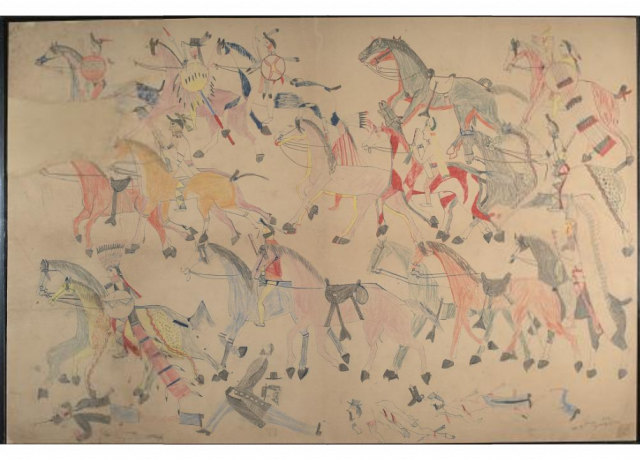 Red Horse pictographic account of the Battle of the Little Bighorn, 1881
Red Horse pictographic account of the Battle of the Little Bighorn, 1881Posted on 01/21/2019 12:17:14 AM PST by vannrox
In most cases, movies based on real incidents tend to make those events more exciting. Not so in the case of Custer’s Last Stand. Of course, moviegoers wouldn’t likely want to see all of the scalping, animal killing, decapitation and other grim horrors of this battle.
There would not be enough time in these movies to allow for the minor but still intriguing facts surrounding Little Big Horn.
These facts and/or believed stories are well worth to read!
The Cavalry, armed with single shot carbines was no match against Native Americans with far more firepower. They were up against 100 repeating Winchesters and more Indian firearms numbering as many as 350 total. It was an onslaught they were unprepared for.
These Cavalry soldiers were possibly not all well trained. There were several minors that were not yet of military age among them, and several of the men found in archeological excavations were not in military uniform. Indian accounts of the battle describe the men as scared and in a panic.
By most accounts, many of the men ran away from the carnage to make defense farther up, and it was on Custer Hill that Lt. Edward Godfrey and General Edward McClerand (and later confirmed by archeologists) found the bodies of Cavalry men surrounded by a circle of dead horses.
“On top of Custer Hill was a circle of dead horses with a 30-foot diameter, which was not badly formed. Around Custer some 30 or 40 men had fallen, some of whom had evidently used their horses as breastworks.” – General McClerand
“Numerous dead horses were lying along the southwestern slope of Custer Hill. On the very top were found four or five dead horses that were swollen, putrid, and offensive, their stiffened legs sticking straight out from their bodies. Close under the brow of the hill several horses are lying together, and by the side of one of these Custer was found.” – Colonel John Gibbon
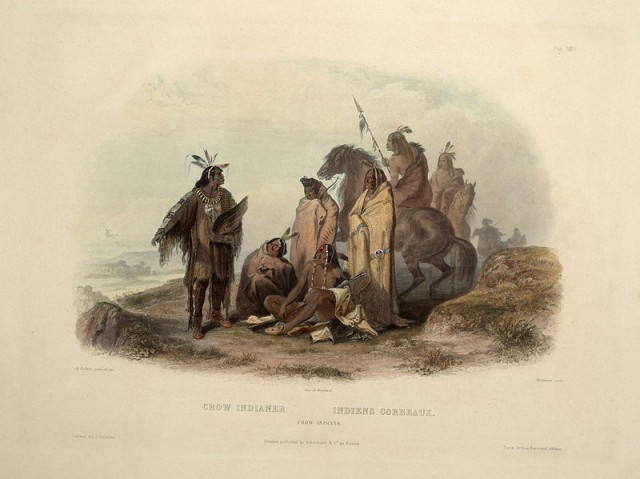 Crow indians
Crow indiansCrow Chief Plenty Coups had a vision as a child that if his nation was to survive, it would need to befriend the coming white man. He stuck to that his entire life, and upon his death in the 1920s; he donated his home to the National Park Service.
The Crow were originally from Lake Erie, but in the 1700s were pushed Westward by other tribes to first Manitoba, and then by the Cheyenne and Sioux into Montana. The Crow territory included Little Big Horn, and in 1851, that land was included in the reservation boundaries set by the U.S. government for the Crow nation.
For decades, nearly a century, before the formation of the Crow reservation and the Crow’s alliance with the U.S., the Cheyenne, and Sioux had been stealing Crow horses and warring with the less armed nation on a regular basis. They were, in a sense, bullies.
In 1868, after battling with the Sioux, the U.S. signed the Treaty of Fort Laramie, which gave the Lakota Sioux territory up to the crest of the Bighorn Mountains. The Sioux treatment of the Crow became worse, and in the two years leading up to the battle with Custer, it escalated and it further involved the U.S. Army.
The Crow did not have enough numbers to defend themselves and neither did the Army, but together they were better off. Sioux made numerous raids on the Crow and Army outposts, and the Crow would often sacrifice their warriors in attempts to recover stolen horses and goods.
Indian Agent Dexter Clapp began to plead with the government for assistance in helping the Crow. He said, “As long as they are being driven from point to point, there is no use asking them to settle down and farm.” Clapp himself, in the meantime, armed the Crow with guns and ammunition. “The Sioux are now occupying the eastern and best portion of their reservation, and by their constant warfare, paralyzing all efforts to induce the Crows to undertake agriculture.”
It wasn’t only the Crow that were being pushed around by the Sioux; other nations included Shoshone, Blackfeet, and Arikaras.
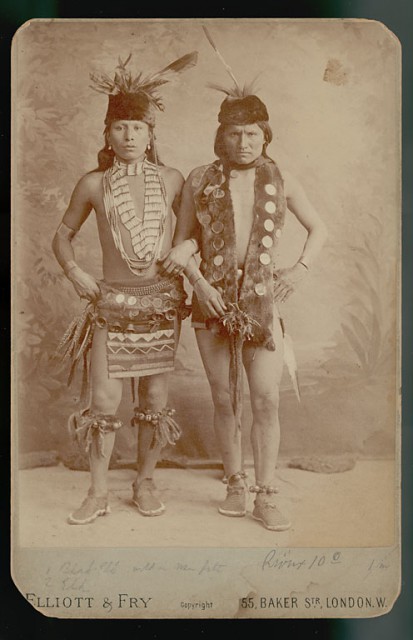 Black Elk and Elk – Oglala Lakota
Black Elk and Elk – Oglala LakotaDuring the battle, in addition to scalps, the Sioux took things from the soldier’s bodies that intrigued them.
Watches were seen only as an object that ticked, and once the ticking stopped, they were mostly discarded. Black Elk says of one that he took from a soldier’s belt “It was round and bright and yellow and very beautiful, and I put it on me for a necklace. At first, it ticked inside and then it did not anymore.”
They also found compasses and saw that the needle floated and moved when the compass case was turned. Because of their position to the bodies of the dead soldiers, the compass happened to point at the bodies. They concluded that the device was attuned to the soldiers, and that’s how the white men found each other.
Paper money was of no use as it was seen as green art and was given to the children or thrown away. The wallets, however, were worth more and were kept – an interesting and opposite perspective than ours, but probably more correct.
The Warriors also found flasks. They assumed the strong, burning liquid inside was “holy water” and that it was this drink that made the soldiers act strangely – shooting at each other and committing suicide in panic.
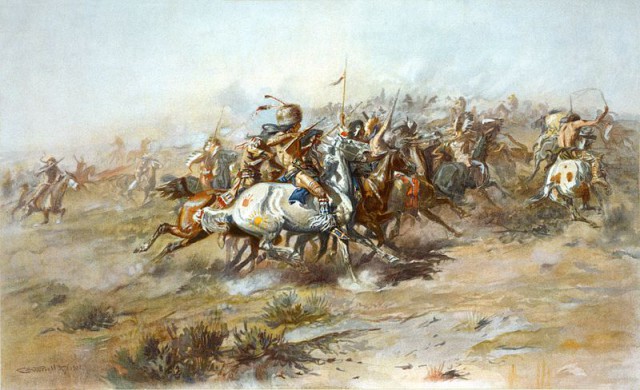 Battle of Little Bighorn
Battle of Little BighornAfter Custer himself fell, the remaining soldiers fled in a disorganized panic toward a stand of cottonwood. The stampede was such that an Indian warrior compared it with a “hunting buffalo”.
“The white men went crazy. Instead of shooting us, they turned their guns upon themselves. Almost before we could get to them, every one of them was dead. They killed themselves.” – Wooden Leg
“More and more soldiers were getting off their horses, preferring to hide or crawl along the ground . . . As hundreds of Indians surrounded this ridge, I saw one of the soldiers point his pistol at his head and pull the trigger. Others imitated his example, sometimes shooting themselves, sometimes each other. When Chief Lame White Man reached the soldiers, all of them were already dead. Indians then attacked the first ridge, and again, most of the white men were already dead. The only thing remaining for the Indians to do was pick up the abandoned guns and ammunition.” – Kate Bighead
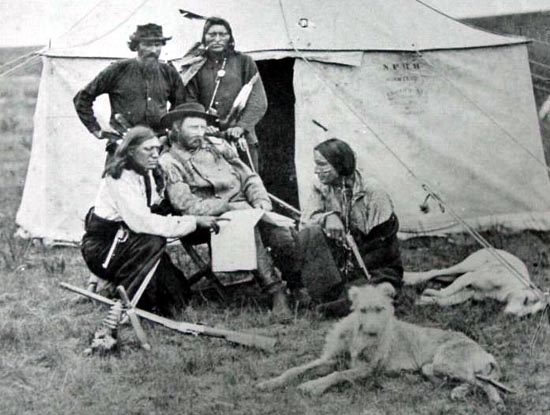 Custer and his dogs with Crow Scouts
Custer and his dogs with Crow ScoutsThere were, of course, horses at Little Big Horn, but there were also other animals – pets among them.
Custer wrote home to his wife “Tuck regularly comes when I am writing, and lays her head on the desk, rooting up my hand with her long nose until I consent to stop and notice her. She and Swift, Lady and Kaiser sleep in my tent.” His dogs were trained to run alongside his horse that could be how Tuck died in the battle. The other dogs had been left at camp with their caretaker.
The horses have far stranger stories. Aside from the trench of horses mentioned above, there were mysterious horses like Little Soldier, the horse of Bobtailed Bull, an Arikara scout working with Major Marcus Reno. After Bobtailed Bull had died in battle, Little Soldier made his way over 300 miles back to his home in the Dakota Territory.
Another horse was found by General Godfrey on the Yellowstone River. It was missing nothing. It had its halter, saddle, and bit – everything down to the oats to feed it. The saddle bags were empty, but the general was told that they did hold a carbine when first discovered. The horse had been shot in the forehead. There was no sign of the rider.
A horse that showed up in Canada after its sale by the Sioux was recovered by the Mounties, and after U.S. approval, the RMP superintendent, James Morrow Walsh was allowed to keep it. He named him “Custer”.
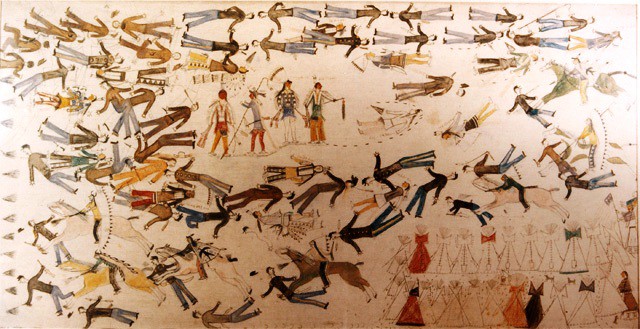 Battle of Greasy Grass
Battle of Greasy GrassThere are several paintings of the battle done by Indians, the most famous of which was done by Kicking Bear, a Sioux warrior and a later performer in Buffalo Bill Cody’s Wild West show. From his perspective, the central focus is himself, Crazy Horse, Rain In The Face, and Sitting Bull. It also features Custer and the departing spirits of the deceased. Red Horse pictographic account of the Battle of the Little Bighorn, 1881
Red Horse pictographic account of the Battle of the Little Bighorn, 1881
Red Cloud also shared his perspective in a pictograph.
Captain Grant Marsh of the Far West Steamboat was the first to deliver the news of what happened at Custer’s Last Stand. His mission had been to take supplies to Custer, but instead, he ferried 51 wounded soldiers away from the massacre.
To do this, he had to drop some weight. Rather than drop the fuel needed for steam, or supplies needed for the men, he chose to drop $375,000 worth of gold bars on the shores of the Bighorn River. It has never been recovered.
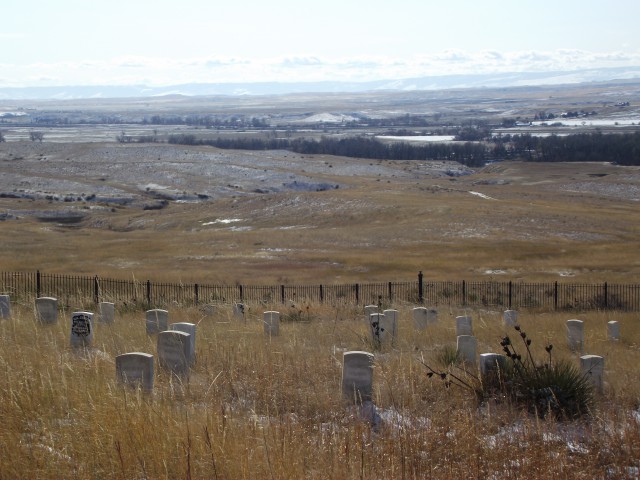 Little Bighorn Battlefield National Monument Montana. By 1025wil CC BY-SA 3.0
Little Bighorn Battlefield National Monument Montana. By 1025wil CC BY-SA 3.0If you visit the battlefield at Little Big Horn, there is a visual cue for gaining perspective on how the battle went down.
Each marble marker marks the spot where a soldier fell. Originally, they were buried where they died, but the bodies were moved later. The markers remain.
The places where the soldiers fell are marked with white marble headstones, so from afar you can get a picture of what the aftermath looked like.
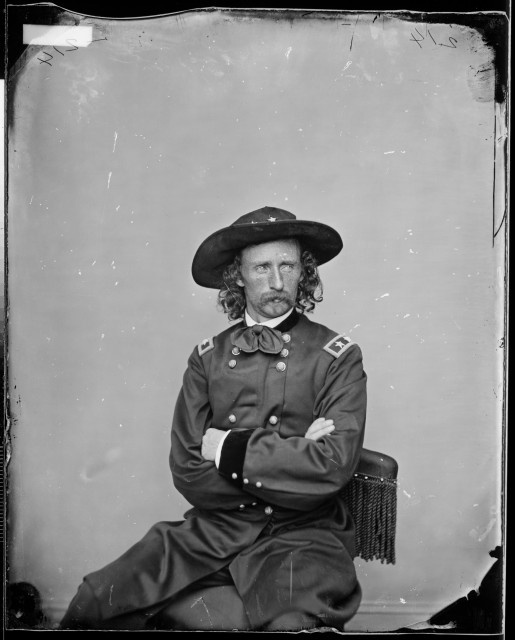 Gen. George A. Custer
Gen. George A. CusterCuster’s life is a mishmash of failure, brazen luck, and some success, but he wasn’t the hero or anti-hero portrayed in movies.
He was known as a prankster at West Point and graduated as the lowest ranking cadet.
Most people believe he was a general, and he was for a while during the Civil War – a Brevet Major General. After the war, the rank reverted to Captain and remained so for the rest of his career.
He was court martialed twice – once for going AWOL to visit his wife.
During a campaign in Texas, the soldiers continually gave him gruff and balked at his discipline, and thought of him as a “vain dandy.” Custer was known for his appreciation of his hair and his attention to it with cinnamon oil for scent and other treatments.
Most of the legend surrounding Custer was embellished or even made up by Custer’s wife during speeches throughout her life, and by the shows put on by a friend and fellow soldier, Buffalo Bill.
It’s amazing what modern archeology and good investigation can accomplish.
Studies underway at Little Big Horn Battlefield National Monument are so advanced that researchers can find a bullet on the ground and track where it was shot from, who shot it, and how adept at fighting the soldier was.
They conduct their research with metal detectors and microscopes and match firing pins to rifle cartridges. They are also working with new translations of Native American accounts of the battle.

Long ago I read a book about the western frontier in the mid 18th century. One torture account really stuck with me. The Indians opened up your abdomen, tied one end of your intestines to a stake, and forced you to walk around the stake, winding your intestines thereupon.
Not sure if it is true, but how ghastly and horrible that would be.
Custer was born in Michigan.
Doesn’t that make him a “Native American” too?
BKMK
Pleasanton's reputation has not fared well, but one of his great services to the cause was to promote three young officers -- Custer, Elon Farnsworth and Wesley Merritt -- to brigade command. They were chosen quite specifically for their aggressiveness, the idea being to get out and smoke Jeb Stuart. Farnworth was killed at Gettysburg (at age 25), but Custer and Merritt emerged, along with Tom Devin, as a highly competent command trio that in 1863-64 slowly wrested cavalry dominance away from the confederates. John Buford might well have figured prominently in this command evolution as his star had steadily risen, but he fell ill and died in the winter of 1863. It's a small world department: one of Buford's aides at the time of his death, and present at the bedside, was Myles Keough, who would die with Custer at the Little Bighorn. Devin was one of Buford's brigade commanders at Gettysburg.
But we have made so much progress beyond what the left wants for us. There's always some lefty idiot trying to stir trouble. It will be up to us conservatives, to unite all our people in common cause for freedom and to build a future for all of us together.
Keough was born in Ireland and as a young man volunteered to fight for the Pope in the Italian wars of the time. He served gallantly, became an officer in the Papal forces, and was for a time a member of the Irish company in the Vatican Guard. When peacetime service in the Vatican proved boring, he came to America to find adventure. In this, he succeeded. He was a classic 19th century soldier of fortune and adventurer.
Keough's most colorful Civil War moment came at Port Republic in the 1862 Valley Campaign, when he led the Union cavalry detachment, ranging ahead of Shields' division, that dashed unexpectedly into town and almost captured Stonewall Jackson and his staff. The confederates had been preoccupied with Fremont's command approaching from the west. They had beaten Fremont at the Battle of Cross Keys the previous day and had been careless about Shields' approach from the north, which led to the close-run Battle of Port Republic.
There are many accounts through the centuries detailing the sort of things Indians did to captives.
Custer wrote articles for a hunting magazine. He boasted about perfecting the technique of shooting a buffalo with a pistol on a dead run. What he didn’t mention was that he shot 2 horses out from under him in perfecting the process.
One interesting thing I heard several times during military history and strategy classes was that Custer had two horse-drawn Gatling Guns available to him, but left them at the fort because he thought they’d slow him down.
Bet he regretted that decision later on.
Also, on the monuments at Little Big Horn listing the Indians killed there, is one brave named “Plenty Lice”.
Bet he was really popular.
A quick Google search found this:
9. Tying Intestines Around a TreeOkay, the technical term for this is disembowelment, which has been a pretty common practice throughout history. But there have been rare cases where the victims' intestines were pulled out, tied/nailed to a tree and then they were made to run around the tree which resulted in eventual death. The tree below is one in Cuylerville, NY, where in 1779, Lt. Thomas Boyd was tortured and killed when Seneca chief Little Beard tied his intestines around the tree and made him run around it.
Reno had ordered his detachment to dismount after he crossed the river, instead of charging hellbent into the Indian encampment. He turned his cavalry into badly outnumbered infantry, which got torn to pieces once the Indians counterattacked.
How did the Indians obtain their superior firepower?
It is amazing to me that almost every american knows about custer. Graduated last in his class and managed to get his entire company wiped out. How many know about Ranald S Mackenzie? In same west point class as custer , but graduated at top of class. was able to defeat and force onto reservation the comanche indian tribe without losing a single man at palo duro canyon. Found their winter camp and destroyed their food supplies and more importantly their pony herd. They were forced to walk to oklahoma reservation or starve.
From gun runners.
“If this man got a couple of miles away before shooting himself, his body may have been missed, but we just don’t know. It’s one of the remaining mysteries of the Custer fight.”
This may be of interest to you:
last survivor of custer’s last stand
https://www.youtube.com/watch?v=BsWZ41mHY4M
That’s not Custer - he was in Virginia in May, 1864.
Indeed so.
By the way, Custer was promoted 5 ranks that day !
It would have been interesting to see what Farnsworth would have contributed had he not had the misfortune of getting killed immediately.
The promotion was just before Gettysburg.
In the movie, they portray the promotion as a mistake, that the generals were going to punish Custer, and accidentally signed his name to the promotion document instead in the confusion of battle.
However, given that Pleasanton promoted all three at once, and that Custer was his aide, it seems to me the promotion was deliberate.
Custer immediately set to work making his special uniform.
However, it was just a few days later that Custer, in disobedience of a direct order to move his forces, stayed and helped fight Jebs cavalry in the east Gettysburg battle.
Lees plan was a pincer move. The Cavalry was to arrive in the rear.
Had not Custer stayed and stopped the confederate cavalry, the battle may have been lost. It was a close enough run as it was.
Custer led his cavalry charges in repeated charges and saved the day.
https://www.youtube.com/watch?v=j9flLRKJivI
https://www.sierratoysoldier.com/ourstore/pc/Custer-Charge-at-Gettysburg-c1234.htm
Bttt.
5.56mm
No background checks.
Disclaimer: Opinions posted on Free Republic are those of the individual posters and do not necessarily represent the opinion of Free Republic or its management. All materials posted herein are protected by copyright law and the exemption for fair use of copyrighted works.